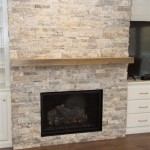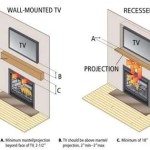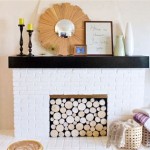Fireplace Panel Replacement: A Comprehensive Guide
Fireplace panels, also known as firebacks or refractory panels, are integral components of a fireplace system. Their primary function is to protect the firebox walls from the intense heat generated during combustion. Over time, these panels can degrade due to thermal stress, physical impact, and chemical reactions with combustion byproducts. Replacing damaged fireplace panels is crucial for maintaining the efficiency and safety of the fireplace.
This article provides a detailed overview of fireplace panel replacement, covering aspects ranging from identifying the need for replacement to selecting the appropriate panels and executing the replacement process. The information presented aims to equip homeowners and professionals with the knowledge necessary to undertake this maintenance task effectively.
Recognizing the Need for Fireplace Panel Replacement
Several indicators suggest that fireplace panels require replacement. Identifying these signs early can prevent further damage to the fireplace structure and reduce potential safety hazards. Regular inspection of the firebox interior is therefore essential. Some of the most common signs include:
Cracks and Fractures: The appearance of cracks, ranging from hairline fractures to significant breaks, is a primary indicator of panel degradation. Thermal expansion and contraction, coupled with the corrosive effects of combustion gases, cause these cracks to develop. Small hairline cracks might appear insignificant initially, but they tend to widen and deepen over time, compromising the panel's structural integrity.
Crumbling and Disintegration: Over prolonged exposure to high temperatures and harsh combustion products, fireplace panels can begin to crumble or disintegrate. This process often starts at the edges and corners, gradually spreading across the entire surface. The disintegration of the panel material reduces its insulating capacity and weakens the firebox walls' protection.
Warping and Deformation: Excessive heat can cause fireplace panels to warp or deform, altering their original shape. This distortion can affect the firebox's dimensions and potentially create gaps, leading to heat loss and reduced efficiency. Warped panels may also become unstable and prone to further damage.
Dark Staining and Sooting: While some sooting is normal, excessive dark staining, particularly concentrated in specific areas of the panels, can indicate underlying damage or deterioration. This staining may be due to moisture penetration or uneven heating, both of which can accelerate panel degradation.
Reduced Heating Efficiency: A noticeable decrease in the fireplace's heating efficiency, despite using the same amount of fuel, can be attributed to damaged or deteriorated fireplace panels. Gaps and cracks in the panels allow heat to escape, reducing the overall heating performance.
If any of these signs are observed, a thorough inspection by a qualified professional is recommended to assess the extent of the damage and determine the appropriate course of action. Delaying repairs can lead to more significant problems, including damage to the surrounding masonry and potential fire hazards.
Selecting the Appropriate Replacement Panels
Choosing the correct replacement panels is critical for ensuring the longevity and optimal performance of the fireplace. Several factors must be considered when selecting new panels, including material type, dimensions, and compatibility with the existing fireplace system.
Material Type: Fireplace panels are typically made from refractory materials, known for their ability to withstand high temperatures without degrading. Common materials include:
Firebrick: A traditional choice, firebrick is a durable and cost-effective option. It offers excellent heat resistance and is suitable for most fireplace applications. Firebrick is commonly available in standard sizes and can be cut to fit specific firebox dimensions.
Refractory Cement Panels: These panels are made from a mixture of refractory cement and aggregates, providing a smooth and uniform surface. They are often pre-cast into specific shapes and sizes, making installation easier. Refractory cement panels offer good heat resistance and are relatively easy to maintain.
Calcium Silicate Panels: These panels are lighter than firebrick and refractory cement panels, making them easier to handle and install. They offer good insulation properties and are resistant to thermal shock. Calcium silicate panels are often used in modern fireplace designs.
Ceramic Fiber Panels: Offering excellent insulation and lightweight, ceramic fiber panels are often used in high-efficiency fireplaces. They are less durable than firebrick, however, and can be prone to surface damage. Proper handling is necessary during installation to avoid damaging the panel.
Dimensions and Shape: Accurate measurements of the existing fireplace panels are essential for selecting replacement panels of the correct size and shape. The thickness, length, and width of the panels must match the original specifications to ensure a proper fit and optimal performance. If the existing panels are irregularly shaped, precise templates may be required to create custom-cut replacements.
Compatibility: Ensuring compatibility between the new panels and the existing fireplace system is crucial. Consider the type of fuel used (wood, gas, or pellets), the fireplace's design, and any specific manufacturer recommendations. Using incompatible panels can lead to performance issues, reduced lifespan, and potential safety hazards.
Manufacturer Recommendations: Consulting the fireplace manufacturer's guidelines is highly recommended. These guidelines often provide specific recommendations for replacement panel materials and dimensions, ensuring optimal performance and safety. Adhering to these recommendations can also help maintain any existing warranties.
It is wise to consider a professional opinion when selecting replacement panels, particularly if the fireplace is an older model or has unique design characteristics. A qualified technician can assess the specific requirements and recommend the most appropriate panels for the application.
The Fireplace Panel Replacement Process
Replacing fireplace panels is a task that requires careful planning and execution. While some homeowners may choose to undertake this project themselves, professional installation is generally recommended, especially for complex or older fireplace systems. The following outlines the key steps involved in the replacement process:
Preparation: Before starting the replacement process, gather all the necessary tools and materials. This usually includes the replacement panels, a hammer, a chisel or pry bar, a wire brush, a vacuum cleaner, a trowel, refractory mortar, safety glasses, gloves, and a dust mask. Protect the surrounding area with drop cloths to prevent damage from debris.
Removal of Old Panels: Carefully remove the old fireplace panels. Use a hammer and chisel or pry bar to loosen the mortar or adhesive holding the panels in place. Gently pry the panels away from the firebox walls, taking care not to damage the surrounding masonry. Wear safety glasses and a dust mask to protect against flying debris and harmful particles. Dispose of the old panels properly, following local regulations.
Cleaning the Firebox: Thoroughly clean the firebox interior to remove any remaining mortar, ash, soot, or debris. Use a wire brush to scrub the walls and joints, and then vacuum the entire area to remove loose particles. A clean surface will ensure a strong bond between the new panels and the firebox walls.
Applying Refractory Mortar: Prepare the refractory mortar according to the manufacturer's instructions. Apply a generous layer of mortar to the back of each new panel and to the corresponding area on the firebox wall. Ensure that the mortar is evenly distributed to create a strong and uniform bond.
Installing the New Panels: Carefully position each new panel in its designated location, pressing it firmly against the firebox wall. Ensure that the panels are aligned correctly and that there are no gaps between them. Use a trowel to smooth out any excess mortar and to fill any small gaps. If necessary, use shims to hold the panels in place while the mortar dries.
Curing the Mortar: Allow the refractory mortar to cure completely according to the manufacturer's instructions. This typically takes 24 to 48 hours. During this time, avoid using the fireplace to allow the mortar to set properly. Some refractory mortars require a slow heat-up process after curing to ensure maximum strength and durability. Consult the manufacturer's guidelines for specific curing instructions.
Final Inspection: After the mortar has fully cured, conduct a final inspection to ensure that the panels are securely in place and that there are no gaps or cracks. Clean any remaining mortar residue from the firebox interior. A small, controlled test burn can be performed to check the fireplace's performance and identify any potential issues.
While this process appears straightforward, it requires a degree of skill and precision. Incorrect installation can lead to heat loss, reduced efficiency, and potential safety hazards. Therefore, professional installation is often recommended, especially for individuals with limited experience in masonry work.

Fireplace Refractory Panels Woodstoves Fireplaces

Universal Large Fireplace Replacement Stack Brick Refractory Panel

Fireplace Refractory Panels Woodstoves Fireplaces

Fc Refractory Panel Replacement

Expert Manufactured Fireplace Panel Repair Replacement

Superior Wre4542 42 Fireplace White Herringbone Refractory Panels Fireplaces Usa

Repair Your Fireplace Or Firebox Refractory Panel Replacement Parging

Pleasant Hearth Firebrick Panel Set For 36 In Zero Clearance Ventless Dual Fuel Fireplace Insert Zrp360 The Home Depot

Expert Manufactured Fireplace Panel Repair Replacement

Firebox Refractory Replacement








